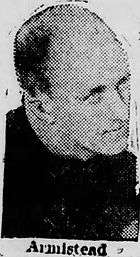Jimmy Armistead
| Vanderbilt Commodores | |
|---|---|
| Position | Running back/Quarterback |
| Class | Graduate |
| Career history | |
| College | Vanderbilt (1926–1928) |
| High school | Hume-Fogg |
| Personal information | |
| Date of birth | August 29, 1905 |
| Place of birth | Nashville, Tennessee |
| Date of death | March 1984 |
| Place of death | Nashville, Tennessee |
| Height | 5 ft 10 in (1.78 m) |
| Weight | 174 lb (79 kg) |
| Career highlights and awards | |
| |
James Cate "Jimmy" Armistead (August 29, 1905 – March 1984) was a college football player.
Early years
James Cate Armistead was born on August 29, 1905 in Nashville, Tennessee to Wirt Mayo Armistead and Sarah Adeline Cate.
High school
Armistead attended Hume-Fogg High School in Nashville, Tennessee. The first game played at Dudley Field was between the home-standing Commodores and the powerful Michigan Wolverines. A goal-line stand by the Commodores preserved a 0-0 tie.[1] The following Friday, nearby Hume-Fogg High School played a game at Dudley. Senior Jimmie Armistead returned the opening kick for a touchdown, providing the first touchdown ever recorded in the stadium.

Vanderbilt
Armistead was a prominent running back for the Vanderbilt Commodores of Vanderbilt University from 1926 to 1928. He was also bald,[2] called by one writer "the bald eagle of Vanderbilt."[3]
1926
He started slow; "Nature neglected to endow him with pugnacity; Or even aggressiveness. As a sophomore he was so timid on attack that he was as easy to snuff out as a candle."[4] He was always shy, and took no joy in seeing his opponent fail.[5] In 1926, Vanderbilt lost its only game to national champion Alabama. Armistead once caught a pass in the game and was tackled just a few yards short of the goal without fighting for extra yardage. From there Vanderbilt failed to score; and so some Vanderbilt fans blamed Armistead for the loss.[5]
1927
He took the criticism of 1926 to heart and emerged a new player in 1927.[5] Armistead led the nation in scoring in 1927 with 138 points,[6] a year in which he was a target of quarterback Bill Spears.[7]
1928
When Spears graduated, Armistead was the triple-threat option,[4] i.e. he now had to pass and kick, as well as captain.[8] Armistead starred in the 14 to 7 victory over Kentucky.[9] He made the second-team of the composite All-Southern eleven behind Florida quarterback Clyde Crabtree.[10]
See also
References
- ↑ "Vanderbilt Stadium". Vanderbilt Athletics. Retrieved September 8, 2007.
- ↑ "Family Stuff, Says Armistead, As He Explains His Bald Head". The Pittsburgh Press. August 26, 1928.
- ↑ "Southern Grid Teams to Lose Many Stars At Close of Season". The Evening Independent. December 1, 1928.
- 1 2 Blinkey Horn (November 13, 1928). "Armistead of Vanderbilt Dixie's Brightest Star". The Milwaukee Journal. Retrieved March 28, 2015 – via Google news archive.

- 1 2 3 "Bald Headed Grid Captain Leads Vandy". The Montana Standard. November 13, 1928. p. 13. Retrieved March 28, 2015 – via Newspapers.com.

- ↑ Ernie Couch. SEC Football Trivia.
- ↑ Mark Purcell (November 1988). "Spears and Vandy excitement in 1927" (PDF). College Football Historical Society. 2 (1).
- ↑ "Southern Star". Daily Illini. September 28, 1928.
- ↑ "Leads Vanderbilt Attack" (PDF). The Technique. November 9, 1928.
- ↑ "All Southern Selections". The Kingsport Times. December 7, 1928.